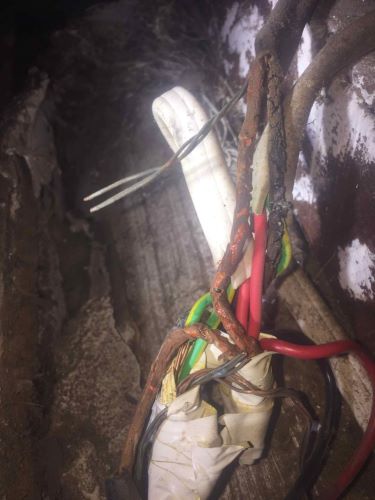Damaged Vulcanised Indian Rubber Cable (VIR)
As a home or business owner, it is your sole duty to ensure that your electrical system is in proper working condition. The wiring system in your house or business plays a significant role in carrying electrical energy drawn by the electrical fittings and devices in your home or business.
Vulcanised Indian Rubber or VIR cables were widely used in Australia’s homes and businesses between 1910 to late 1950s.
This electrical wiring is insulated by cotton and poses a real credible threat for both electrical fire and electrocution.
It has been proven that with over time, VIR cable wiring systems can break down and becoming extremely hazardous. The insulation material used on VIR cables will dry out and become brittle with time leaving behind exposed live electrical wires. What’s more, the earthing system can easily become compromised. As a result, the risk of electrical fires, electrocution, shock or injury to yourself your family or employees.
Potential Rodent caused damage
Electrical Danger
Have you ever wondered why rodents would chew on electrical wiring? Well, the truth is they’ll chew on just about anything. With rapidly growing teeth, rodents are constantly looking for things to chew on in order to file down their long pearly whites. Electrical damage caused by rodents is not only costly but can be incredibly dangerous. Fires can start quite easily if the protective covering is gnawed from the wires.
Often these hazards are hidden and are not discovered until it is too late. Early signs of such damaged cables are frequently tripping Breakers or safety switches and also by conducting an Insulation Resistance and Earth Loop Impedance test. If any of these test fail the wiring consistency is no longer safe and the cable needs to be disconnected from the power source until it has been replaced with new TPS cable.
The insulation resistance between the conductors of consumer mains and sub-mains; and live and earthed parts of an electrical installation, or parts thereof, including consumer mains and sub-mains, shall be no less than 1 MOhm.
NOTES:
For shorter cable runs, the insulation resistance should be significantly greater than 1 MOhm, e.g. for polymeric cables up to 50m a value in excess of 50 MOhm would be expected.
Refer to the Australian wiring rules: AS/NZS 3000 - Clause 8.3.9 Table 8.1
For MCBs:
-16A at 0.4s = <1.9ZsO
-20A at 0.4s = <1.5ZsO
For Fuse: -16A at 0.4s = <3.1ZsO
-16A at 0.5s = <5.0ZsO





